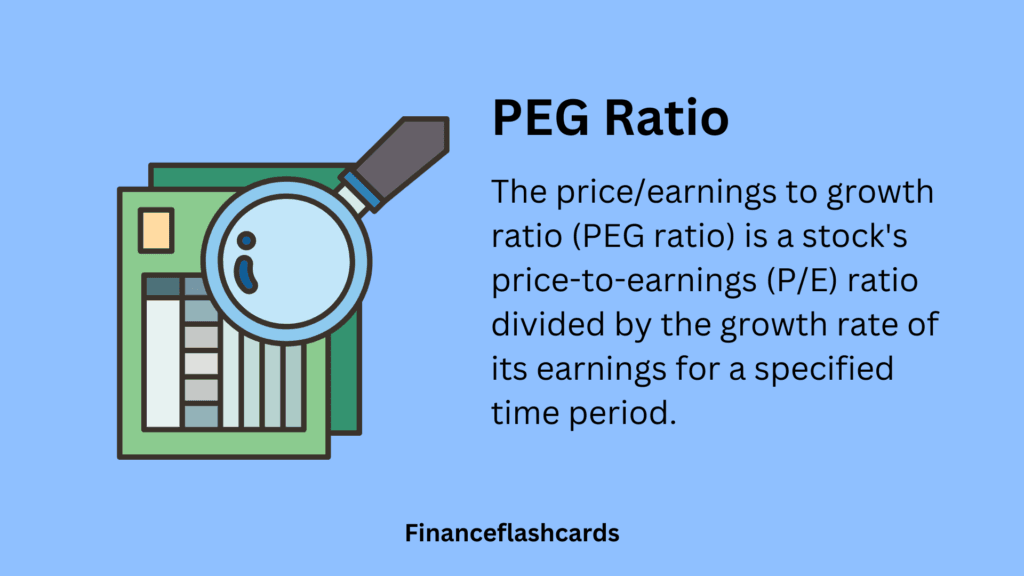The PEG ratio is a company’s Price/Earnings ratio divided by its earnings growth rate over a period of time.
Table of Contents
What Is PEG Ratio?
The price/earnings to growth ratio (PEG ratio) is a stock’s price-to-earnings (P/E) ratio divided by the growth rate of its earnings for a specified time period. The PEG ratio adjusts the traditional P/E ratio by taking into account the growth rate in earnings per share that are expected in the future.
PEG ratio is used to value a stock and it is a better metrics to evaluate stock as it also take consideration of growth rate of the company.

What is the PEG Ratio Formula?
The PEG ratio formula for a company is as follows:
PEG = P/E Ratio / Earnings per Share growth rate
For example if company A P/E ratio is 20 and growth rate is 5%, then PEG ratio: 20/5 =4
In theory, a PEG ratio value of 1 represents a perfect correlation between the company’s market value and its projected earnings growth. PEG ratios higher than 1.0 are generally considered unfavorable, suggesting a stock is overvalued. Conversely, ratios lower than 1.0 are considered better, indicating a stock is undervalued.
Why PEG Ratio Is Better than P/E Ratio?
The price-to-earnings (P/E) ratio gives analysts a good fundamental indication of what investors are currently paying for a stock in relation to the company’s earnings. One weakness of the P/E ratio, however, is that its calculation does not take into account the future expected growth of a company. The PEG ratio represents a fuller—and hopefully—more accurate valuation measure than the standard P/E ratio.
The PEG ratio builds upon the P/E ratio by factoring growth into the equation. Factoring in future growth adds an important element to stock valuation since equity investments represent a financial interest in a company’s future earnings.
How to Interpret PEG Ratio?
According to Peter Lynch, an eminent financial and value investor, a PEG ratio of 1 denotes equilibrium. This equilibrium is between the perceived value of a stock’s worth and its earning potential. For better understanding, take a look at the following PEG ratio analysis.
For instance, if a company has a P/E ratio of 20 and its earnings growth rate is also projected as 20, then it means that the market has correctly perceived its value.
On that note, a PEG ratio above and below 1 would imply that the market has wrongly perceived such stock’s value. In case the PEG ratio of a stock is above 1, it means the market has overestimated its worth in relation to its earning potential.
For example, let’s assume that stock A has a P/E ratio of 12 and an EPS growth rate of 10%. Therefore, its PEG ratio would be 12/10 = 1.2. It says that the market is currently overestimating such a company’s projected earning potential by 20% and thus, it is overvalued.
In case the PEG ratio of any stock is below 1, it means that the market has underestimated its value in relation to its projected earning potential.
For instance, let’s consider the hypothetical stock A mentioned above. If its P/E ratio remains unchanged and its EPS growth rate is revised at 15%, then its PEG ratio would come to be 0.8. It means that the market is underestimating its earning capacity by 20%, and thus, it is undervalued.
However, there are other inferences to PEG ratios that are above and below 1. A PEG ratio above 1 could mean that investors consider its EPS growth rate inaccurate or the stock might have heightened demand due to other related factors.
Similarly, a PEG ratio below 1 could also mean that investors consider the projected growth rate to be inaccurate, or it might imply a lower demand for that stock due to other relevant factors.

The Bottom Line
The PEG ratio is used to calculate a company’s value while taking into account growth. It is more resilient than the P/E ratio, which solely considers price-to-earnings and does not account for growth.
When examining equities, those with a PEG ratio less than 1.0 are considered inexpensive and may provide an investment opportunity. All financial ratios should not be used in isolation, but rather in conjunction with others to provide a comprehensive view of an asset.

